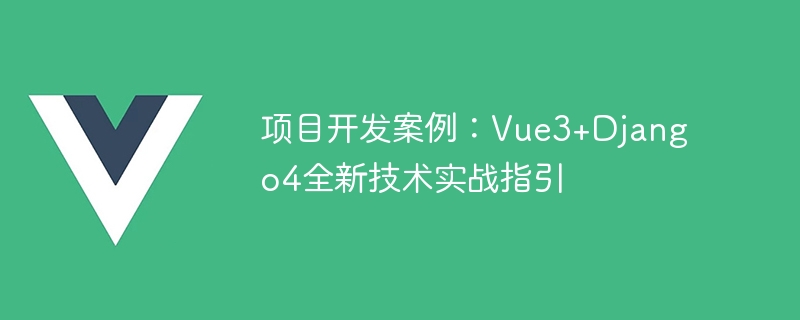Home >Web Front-end >Vue.js >Project development case: Vue3+Django4 new technology practical guide
Project development case: Vue3+Django4 new technology practical guide
- 王林Original
- 2023-09-10 10:00:411293browse

Project Development Case: Vue3 Django4 New Technology Practical Guide
Introduction:
Nowadays, Web development has become a hot spot in today’s Internet industry, and various new technologies Technologies are constantly emerging, bringing more possibilities to web development. Among them, Vue3 and Django4, as representatives of front-end and back-end development, have high popularity and wide application. This article will introduce the use of Vue3 and Django4 through an actual project development case to help readers better master the application of these two technology stacks.
1. Project background
We need to develop an online blog system where users can browse, search and comment on blog posts, while administrators can publish, edit and delete posts.
2. Technology selection
- Front-end framework: Vue3
Vue is a popular JavaScript framework that provides responsive data binding and component-based development methods. Compared with Vue2, Vue3 has greatly improved performance and development experience, and it is worth trying. - Back-end framework: Django4
Django is an efficient Python back-end framework that provides rich functionality and an easy-to-expand development method. Django4 has some improvements in performance and security compared to Django3, so we chose the latest version for development.
3. Project structure
- Front-end project structure
-
src
- assets: Store static resource files
- components: Store Vue components
- views: Store page-level Vue components
- router.js: Define routing
- main.js: Entry file
- Backend project structure
-
blog
-
apps
- account: User management Related applications
- blog: Blog management related applications
-
config
- settings.py: Configuration file
- urls.py: Routing configuration
##manage.py: Startup file - requirements.txt: Dependent library file
-
- Create Vue3 project
- Use command line tools to create an empty Vue3 project and install the necessary dependencies. Then create routing and page components and define routing and navigation. Develop various page components to implement blog browsing, search and comment functions. Finally, beautify the style and optimize the performance.
Interaction with the backend - Use Vue's axios library to interact with the backend data, including obtaining blog lists, searching blogs and commenting functions. Use tokens for user authentication to ensure the security of operations.
- Create Django4 project
- Use command line tools to create an empty Django4 project and install the necessary dependencies. Create blog applications and user management applications, and define corresponding data models and API interfaces.
Implement the API interface - Write the API interface for blog list, blog search and comment functions, and use the CBV (Class-based views) provided by Django for development. Query and operate data in the view, and perform data serialization and verification.
Database Design - Create database tables for blogs and users, and set corresponding field attributes, relationships and data constraints to ensure data consistency and integrity.
Put the static files built by the front-end into the Django static file directory, and then start the Django development server. Test in the browser to ensure that the interaction between the front and back ends is normal and the functions can be used normally.
- Front-end optimization
- Reduce the loading time of static resources, use Vue's asynchronous components for on-demand loading, and code compression and packaging.
Back-end optimization - Use caching technology to reduce the number of database queries and cache frequently accessed data. Use asynchronous task queues to handle some time-consuming operations and improve system response speed.
Project deployment - Put the static files generated by the front-end packaging into the Nginx server, and use Gunicorn to deploy the Django project. Use Supervisor for process management to ensure the stable operation of the project.
Through this practical project, we learned the basic usage of Vue3 and Django4 and how to combine the two to develop a complete Web application. At the same time, we also introduced some noteworthy points and some optimization techniques in the front-end and back-end development process. I hope this article can help readers better master the use of Vue3 and Django4 and improve their development capabilities.
The above is the detailed content of Project development case: Vue3+Django4 new technology practical guide. For more information, please follow other related articles on the PHP Chinese website!

